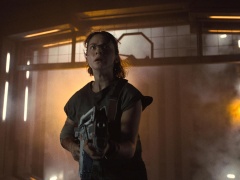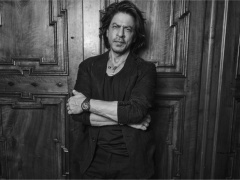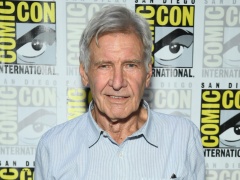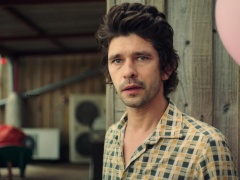
One of Norway’s biggest export names, whose credits include Juliette Binoche starrer “1,000 Times Good Night” and Golden Bear nominee “Utøya- July 22,” director Erik Poppe will kick off the Norwegian Film Festival in Haugesund on Aug. 18, with his much-anticipated drama “Quisling – The Final Days,” ahead of the film’s international premiere at Toronto’s Special Presentations.
Although set in Norwayduring WWII, the film explores today’s pressing issue of the rise of right wing extremismand its threat to democracy.
It centres on the last days before his execution on Oct. 24, 1945, of the infamous Nazi collaborator Vidkun Quisling, whose name has become a byword for traitor. As Quisling sits in his dark cell, he receives the visit of the priest Peder Olsen. Their encounters – documented in a diary written by Olsen that served as a key source for the script – turn into a psychological battle between the humanist and the fascist.
AI Content Licensing Deals With Publishers: Complete Updated Index

HBCU Football Games Coming to Fox-Owned Stations in Los Angeles and Chicago Through Allen Media Group Deal
Delivering tour-de force performances are Gard B. Eidsvold (“Troll,” “In Order of Disappearance”) as Quisling and Anders Danielsen Lie (“The Worst Person in the World”) as the priest, cast alongside Lisa Carlehed (“The Emigrants”) as Maria Quisling and Lisa Loven Kongsli (Force Majeure”) as the priest’s wife Heidi Olsen.
based on a script by Anna Bach-Wiig, Siv Rajendram Eliassen and Ravn Lanesskog, the film was produced by Poppe’s regular partners Finn Gjerdrum and Stein B. Kvae of Paradox, SF Studios’ Norwegian production banner. The feature and aseparate TV version are being sold internationally by REinvent.
Speaking in exclusivity to PvNew ahead of the film’s world premiere, Poppe discussed his vision, testing, pushing it and upcoming projects: Relationship drama “Bad Moon Rising,” based on a script by Nobel Literary Prize winner Jon Fosse, and first genre movie “The Scream” inspired by Edvard Munch’s celebrated painting.
This is your third instalment in a trilogy about far-right ideologythreatening democracy, after “The King’s Choice” and “Utøya, July 22.” While the first two films gave the point of view of the victims, here you tackle the subject from a more controversial perspective – the perpetrator, as you try to explore what is behind Quisling’s motives and if redemption is ever possible. Why did you want to go that route with this film?
Erik Poppe: That’s correct. But going back to the very beginning, I started to look into the story of one of the biggest traitors in Europe, back in 2003. Already in the early 2000 in Europe, you could see authoritarian leaders and far right movements gaining ground. I spent a few years reading, researching, but couldn’t find the key to the story.
I directed “The King’s Choice” about the German attack on our democracy in Norway, followed by “Utøya, July 22,” about the terrorist attack on the young people on Utøya [on July 22, 2011]. Then one day I got a diary from a family member of the priest Peder Olsen who was with Vidkun Quisling in his cell in his final days. His family knew I was researching his life.
Suddenly I realised this is the key to the story. Not who Quisling was during the war, neither who he was as a young man. I had to focus on those few days when he was arrested until his death sentence and execution. His fight to survive, to save his reputation, to explain his actions. The diary offers an exclusive inside look of his mindset. The core of the story is therefore the battle between the humanist Olsen and the Fascist Quisling.
A priest is not allowed to disclose a confession. What exactly was in the diary?
EP: The diary included notes that the priest made during his meetings with Quisling. He was a priest working in a hospital for people with mental health issues and was used to dealing with complex personalities. When he was asked to become a spiritual advisor for Quisling in his final days, he was initially afraid he would fail in his task. He made small notes, after every meeting, that showed in a complicated way what was going on. He didn’t really want anyone else to understand his notes so he wrote in a rather cryptic way, to the point where no one could really understand them when the diary was uncovered years back. I took the diary to a theology department of the University of Oslo. They said: ‘Oh it’s not complicated. This is what he says, and these are Quisling’s reactions.’ I took the diary to historians who authenticated it. I was then convinced with my producers that this was an exclusive look into Quisling’s mindset, and we went ahead with the movie. What was also interesting to explore was the priest’s struggle with his own beliefs.
Having uncovered rare information about Quisling, what particular traits of his personality did you find most interesting?
EP: A lot of authoritarian leaders are looking for power for their own sake, to pile up wealth. You can weaken their power by attacking their resources. But the really dangerous anti-democratic leaders that are harder to fight are those driven entirely by their ideology, like Quisling.
The most prominent psychiatrists in Europe came to Norway to study Quisling’s mind, and try to find out if there was something wrong about him. But their diagnosis was that he was actually normal, not a psychopath. He would sympathise with people around him, and was somehow a nice person. How could then a ‘normal’ person like that end up the way he did? Quisling quickly symbolised the biggest threat to our democracy and already in April 1940, Winston Churchill first used his name to define a traitor.
Again, the storyhere is not so much about WWII; it’s very topical as it looks intowhat possiblygoes on in the dangerous minds of autocratic leaders like Quisling, Vladimir Putin, or Viktor Orbán. And I’m not afraid to name them. We are in dangerous times and this is why I’m telling this story.
How did you collaborate with your regular writing partners Siv Rahendram Eliassen and Anna Bache-Wiig, and how crucial was it for you to be historically accurate?
EP: First, I had a rough sketch of the story as I saw it. I first presented it in Cannes 2022 and got a massive interest from potential financiers. I started to work on the script with Anna and Siv. We had collaborated on “Utøya, July 22” and “The Emigrants” before, and we love working in a writers’ room. I went deeper into research while they started building on my idea with the structure. We put layers and layers, developed the script until we ended up with version 13, which is not unusual for us. The writing went on for almost a year. We interviewed elder people who had worked with Quisling, members of the Nazi party, people who were close to the priest. That helped a lot. We also got extra written material from historians. I brought to the writing team two of the most prolific historians when it comes to Quisling who read our material, not to correct it but to say if it was imprecise or wrong.
When I look at some Hollywood period movies, I can tell that some are historically inaccurate, as “the story is the hero.” They play with reality to make the story stronger. That said with some biopics like “Oppenheimer”, the filmmaking team has really put an effort to tell the story as closeto realityas possible. That has a more powerful impact. This is also what we wanted to achieve.

Vidkun Quisling’s Russian wife Maria is another enigmatic and strong character. What can you say about her?
EP: Yes she stood by his side until the very end. He had met her while working in the Ukraine on an emergency relief program there with Fridtjof Nansen, who was awarded the Nobel Peace Prize in 1922 [for his leading role in the repatriation of prisoners of war]. She denied being involved in politics and wasn’t arrested. But she was close to being executed.
Gard B. Eidsvold and Anders Danielsen Lie deliver outstanding performances. Were they obvious choices for you and how did you work with them?
EP: For most of my movies, I invest a lot of time with the actors in rehearsals. Here we spent almost 10 weeks rehearsing. I was able to do this by shortening the filming time, so financially it made sense. I needed very brave actors, willing to open up and to go deep into their characters.
I had Anders in mind for a while and we wanted to find a mutual project. He is already a big name internationally and a regular Joachim Trier collaborator. Gard has been one of the most talented actors in Norway for the last two decades. He has had great second/third roles in many movies but strangely enough hasn’t had a main part. I really wanted to correct this and show the world what an extremely talented actor he is. We shared the idea of creating a character as close as possible to the historic figure. Both Anders and Gard are my friends and it’s wonderful to work with them.
Could you detail your striking visual style, the unusual green and red palette, and camera work?
EP: I am tired of watching period movies shot in blueish, faded colours. I wanted to explore something else. Also, the story is set in 1945, but it’s contemporary in many ways. I felt why not go the opposite way and create a new energy in the visual style. The camera doesn’t move too much, it is controlled, but the colors are powerful. I loved those strong green and red colours. We did a lot of tests with my cinematographer, the Swede Jonas Alarik, with whom I hadn’t worked before. I was keen to bring in new people to this movie, and Jonas has done several great TV shows [“The Playlist,” “Snabba Cash”]. It’s all part of my constant search for innovation and willingness to push boundaries.
I’m lucky to work with great producers [Stein B. Kvae, Finn Gjerdrum] who support me all the way, at a time when a lot of people in the business are terrified to take risks. The trust that exists between us is the most important of all.
I understand you did test screenings, to gauge targeted audiences’ reactions ahead of the film’s delivery. Distributors must appreciate that openness on your behalf…
EP: When I do test screenings, I set them up and run them myself. When I’m in the process of making the film, I’m not afraid of critiques, people saying it’s crap; I want my whole team to challenge my vision.
about half way through the editing, which lasted 35 weeks, I started doing these test screenings every Wednesday evening, inviting 10-15 people, from different focus groups – far right voters, historians, academics, people who never go to the movies, like taxi drivers. We don’t discuss after the screening, just hand out a questionnaire with 22 questions. It’s very helpful. Seeing how the film resonates with the audience helps me to make choices. This is my way, as an artist, to communicate with the audience and check how far I can go. Distributors usually trust me and wait for my final edit.
There will be a TV version of “Quisling-The Final Days”. How will it look like?
EP: The TV cut for the five-episode series will be an entirely different story, with extra material. I shot much more of Maria Quisling’s story, notably in the late 1950s when she travels to get her husband ashes back. There is more of the priest’s wife story as well.
The great thing is that I was able to do something I had never heard of before. I set up two separate edit suites, with different teams for the editing, music and sound, who had no idea what was happening in the other suite. For the sequences in both versions, it was interesting to see how they were attacking it differently. Both versions have different styles and rhythm.
What do you hope audiences will take away from watching your movie?
EP: To be honest, I want to share the idea of what’s going on inside Putin’s mind and other authoritarian figures. People in the test-screenings felt it was shocking to see how relevant this movie is today. What’s important for me is doing highly commercial movies, with a chance to question our world today.
What else are you working on?
EP: I’m currently location scouting on the North-Western coast of Norway for the movie “Bad Moon Rising,” written by the 2023 Nobel Prize of Literature winner Jon Fosse. He is known for his novels, theatre plays, but no one knows that he’s made one single script which he’s asked me to film.
once again, it’s something quite different from my other movies and much shorter in length – about 86-90 minutes. It’s a love story, about a couple in their early thirties, how they meet and separate. It’s a really powerful story, beautifully told, very different fromIngmar Bergman’s “Scenes From a Marriage.” That film goes from argument to argument. It’s so hard and devastating to watch. You just want to cry.
Jon didn’t know about “Scenes From a Marriage” as he doesn’t watch many movies. In his relationship drama, he tells the story in between, with a small chapter, then another one, the couple is together, then not together, then they have a kid, then they aren’t together anymore. It’s about how they cope with their relationship althoughthey feel they are in the wrong place with the wrong person. It’s about the choices we make.
Jon is a huge name in the U.S., Japan and Europe. It’s exciting to work with him and my regular producers at Paradox and SF Studios. The plan is to start filming in November. We have a fantastic cast that we will announce at a later date. This is my 2025 project.Then my 2026 project “TheScream,” also produced by Paradox with SF Studios, will be huge. It’s an international psycho thriller in the English language about Edvard Munch making one of the world’s most famous painting ‘The Scream’. It’s a crazy story which I’ve been working on for a while, but the script is locked. We are already deep into this project and have some partners onboard. We will start with the casting soon to get letters of interest from A-list actors.
Will it be your first genre movie?
EP: Yes. Again for me, it’s all about being brave and taking risks.
This interview was edited for publishing purposes.







